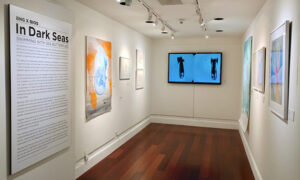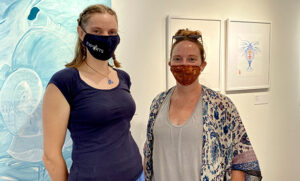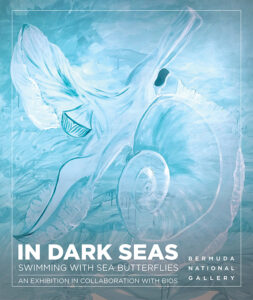A Big Show for Small Organisms

A new collaboration between BIOS and the Bermuda National Gallery (BNG) has resulted in the opening of an exhibit presenting artwork created by artists working with BIOS scientists Leocadio Blanco-Bercial and Amy Maas. Pieces in the exhibit, titled In Dark Seas: Swimming with Sea Butterflies, features two types of zooplankton—copepods and pteropods—that Blanco-Bercial and Maas study. The exhibit is on display in the BNG’s Project Space through October.
Two types of zooplankton will be featured at the Bermuda National Gallery (BNG) beginning this summer in a mixed-media exhibit dedicated to reminding us how art can be used to more deeply appreciate our place on this planet. Copepods, small marine crustaceans, and pteropods, tiny marine snails also known as “sea butterflies,” are the focus of this collaborative effort between BIOS and BNG. Some of the artists with works displayed in the series have spent time at BIOS working alongside zooplankton ecologists Leocadio Blanco-Bercial and Amy Maas as they investigate some of the ocean’s smallest and most critically important members of the marine food web.
The exhibit, In Dark Seas: Swimming with Sea Butterflies, recognizes that art and science are both part of the same human drive to understand what we don’t know. It also sheds light on the role that art and artists can play in connecting scientists, and their findings, with the general public. The exhibit is on display in the BNG’s Project Space through October.

Lesli Bell’s colorful and detailed watercolors of copepods are also on display in the exhibit. She reached out to Blanco-Bercial after seeing a photograph of a copepod under magnification on his laboratory’s webpage and he supplied her with multiple images to work from. The result is a series of paintings that capture the delicate feeding structures and appendages of the tiny marine organisms.
“We would like to thank BIOS for partnering on this engaging exhibition that combines the visual arts and science within a Bermuda context,” said Peter Lapsley, executive director of the Bermuda National Gallery. “The visual arts are, in many ways, about creative problem solving and exploration of ideas, much the same way that science pushes us to better understand the world around us. As we navigate through a world undergoing seismic change in every aspect of life, these sorts of explorations and collaborations couldn’t be more important in presenting ideas and viewpoints to the community.”
The exhibit includes large wall-hangings in acrylic and smaller works in watercolor and ink by artist Samm Newton, as well as detailed watercolors by artist Lesli Bell. BIOS collaborator David Murphy, a mechanical engineer from the University of South Florida who studies the swimming patterns of pteropods, provided a video assembly for one of the gallery walls.

Zooplankton ecologist Amy Maas (left) and research technician Hannah Gossner visited BNG during the early days of the exhibit’s opening. Maas worked closely with one of the featured artists, Samm Newton, during the creation of her ink and watercolor pieces. Newton placed watercolor paper under Maas’s workspace in the lab at BIOS, and while Maas sampled seawater for pteropods, the spilled ocean water became the droplets that Newton used for her watercolors.
Samm Newton: An Artist with a Passion for Interdisciplinary Investigations
Samm Newton was born and raised on the Gulf coast of Texas. The impacts of human activities on the coastal waters she called home inspired her to “more deeply understand the interface between humans and marine systems, and the processes that connect us.” Using an interdisciplinary approach, she earned a Master of Arts in environmental arts and humanities from Oregon State University (United States) studying the role of marine science and technology in how humans think and feel about the ocean.
In 2019, Newton traveled to Bermuda to work with Maas as part of a research project funded by the National Academies Keck Futures Initiative (NAKFI). The Futures Initiative fills a gap in federal funding by providing seed grants that allow scientists from different disciplines to focus on new questions, while also encouraging them to work with artists and designers to foster creative approaches to addressing global issues.
Her NAFKI-funded project, pieces of which are on display at the BNG, examines the types of relationships that emerge when we ask questions about the ocean, especially of its living creatures, like pteropods. It was part of her graduate work at Oregon State University and continues to inform her current doctoral research, which investigates the history of how science and technology have been used to understand nature.
“In 2016 aboard R/V Atlantic Explorer, in the wee hours of the morning, I met a pteropod for the first time,” Newton said. “My life would never be the same. Working with Dr. Maas and Dr. Murphy changed the trajectory of my career and how I think about the more-than-human world. My work with them continues to inform both my creative practice and historical research.”
For Maas, the exhibit offers a unique opportunity to share her work with members of the public who might not ordinarily hear about her research, which focuses on how changes in the environment influence the distribution and biology of plankton species, including pteropods.
“I think the general population does not get to experience the sheer delight and love I have of these animals,” Maas said. “My scientific papers clearly don’t convey that part of my experience of them, but the art and video give people some of that.”
Lesli Bell: A Wildlife Watercolor Painter with An Eye for Detail
Lesli Bell grew up in Bermuda, surrounded by the natural beauty of the island, and began painting fish and underwater wildlife at an early age. She received a Master of Fine Arts from Concordia University (Canada) and spent 25 years painting wildlife in Kenya. Currently, she resides on Christmas Island in Australia where she paints watercolors of fish, birds, crustaceans, and flowers, often on vintage maps, nautical charts, and book pages.
In 2019 Bell reached out to Blanco-Bercial after seeing an image on his lab’s website of a copepod under the magnification of a microscope. He sent Bell additional high-resolution photographs of the small crustaceans, which are distant relatives of crabs and lobsters, and she worked remotely painting highly detailed watercolors that captured the unique appendages and feathery tail-like structures of each organism.
“It was interesting to see what the non-scientist thinks are the interesting morphological [structural] features of the animal, or what they think is unique or flashy,” Blanco-Bercial said. “I usually pay more attention to the taxonomical characteristics that, in general, are not that conspicuous.”
Looking Ahead
Maas and Blanco-Bercial intend to continue collaborating with artists in future projects; in fact, Newton is written into Maas’s most recently funded grant proposal about hypoxia (low oxygen) in the Gulf of California.
“Thinking about something from different points of view just makes you love what you do more,” Maas said. “The world is richer with the broader perspective.”

